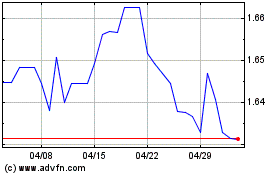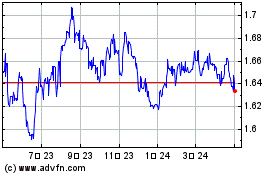Euro Weakens As German Factory PMI Dips To 7-yr Low
2019年7月24日 - 3:17PM
RTTF2
The euro slipped against its major counterparts in early
European deals on Wednesday, after German factory activity expanded
at the slowest pace in seven years in July, as the policy makers at
the European Central Bank gather in Frankfurt to discuss fresh
stimulus measures amid deteriorating economic outlook.
Flash data from IHS Markit showed that German manufacturing PMI
dropped to 43.1 in July from 45.0 in the previous month. Economists
had forecast a score of 45.2. This was the lowest reading in seven
years.
The flash composite purchasing managers' index, or PMI fell to
51.4 in July from 52,6 in June. Economists had forecast a score of
52.3.
The flash services PMI decreased to 55.4 in July from 55.8 in
the preceding month. Economists had forecast a score of 55.2. The
latest reading was the slowest in two months.
Data from the European Central Bank showed that Eurozone's broad
money supply growth slowed more-than-expected in June, while
private sector lending rose unexpectedly at a faster pace.
M3, a broad money aggregate, rose 4.5 percent year-on-year
following a 4.8 percent increase in May. Economists had expected
4.6 percent growth.
The ECB is widely expected to indicate its willingness to ease
further by delivering a rate cut and restart bond purchase program
in September.
The deposit rate that is at a record low of minus 0.4 percent is
expected to be cut by 0.1 basis points to minus 0.5 percent.
The currency showed mixed performance against its major
opponents in the Asian session. While it held steady against the
greenback and the pound, it rose against the franc. Against the
yen, it moved down.
The euro weakened to a new 3-week low of 0.8925 against the
pound, from a high of 0.8968 hit at 7:00 pm ET. The next possible
support for the euro is seen around the 0.88 level.
The European currency depreciated to 1.1127 against the
greenback, a level unseen since May 31. If the euro slides further,
1.09 is likely seen as its next support level.
The euro reached as low as 1.0978 against the franc, just few
pips short to break yesterday's more than a 2-year low of 1.0971.
Next immediate support for the euro is possibly seen around the
1.08 region.
The euro declined to 120.21 versus the yen for the first time
this year. The euro is seen facing support around the 118.00
level.
Final data from the Cabinet Office showed that Japan's leading
index eased more-than-estimated to the lowest level in
six-and-a-half years in May.
The leading index, which measures the future economic activity,
fell to 94.9 in May from 95.9 in April. The initial score for May
was 95.2.
The single currency fell to an 8-day low of 1.4617 against the
loonie from Tuesday's closing value of 1.4641. The currency is
likely to find support around the 1.45 level.
Pulling away from a 6-day high of 1.6656 seen at 2:30 am ET, the
euro trended lower to 1.6605 versus the kiwi. The euro is poised to
find support around the 1.645 level.
Data from Statistics New Zealand showed that New Zealand logged
a merchandise trade surplus of NZ$365 million in June.
That exceeded expectations for a surplus of NZ$100 million and
was up from NZ$264 million in May.
Although the euro eased slightly to 1.5942 against the aussie
after the PMI data, it recovered shortly during the trading
session. This followed a 6-day high of 1.5975 it touched at 3:00 am
ET. The pair was valued at 1.5918 when it ended deals on
Tuesday.
Survey data from IHS Markit showed that Australia's private
sector expanded at a slower pace in July reflecting weakness across
the manufacturing and service sectors.
The Commonwealth Bank of Australia flash composite output index
fell to 51.8 in July from 52.5 in June. Nonetheless, a score above
50 indicates expansion.
Looking ahead, Markit's flash manufacturing PMI for July and
U.S. new home sales for June will be released in the New York
session.
Euro vs AUD (FX:EURAUD)
FXチャート
から 3 2024 まで 4 2024

Euro vs AUD (FX:EURAUD)
FXチャート
から 4 2023 まで 4 2024
